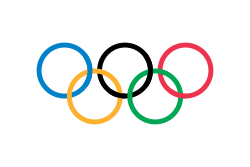Sommer-Paralympics 1992/Judo


Bei den Sommer-Paralympics 1992 in Barcelona wurden in insgesamt sieben Wettbewerben im Judo Medaillen vergeben.
Männer
Superleichtgewicht (bis 60 kg)
| Platz | Land | Athlet |
|---|---|---|
| 1 | Nobuhiro Kanki | |
| 2 | Veniamin Mitchourine | |
| 3 | Davide Albertini | |
| 3 | Woon Noh Cheung |
Halbleichtgewicht (bis 65 kg)
| Platz | Land | Athlet |
|---|---|---|
| 1 | Juan Damian Matos | |
| 2 | Shinichi Ishizue | |
| 3 | Achmed Gadschimagomedow | |
| 3 | Michael Murch |
Leichtgewicht (bis 71 kg)
| Platz | Land | Athlet |
|---|---|---|
| 1 | Simon Jackson | |
| 2 | Mario Talavera | |
| 3 | Pier Morten | |
| 3 | Eiji Miyauchi |
Halbmittelgewicht (bis 78 kg)
Mittelgewicht (bis 86 kg)
Halbschwergewicht (bis 95 kg)
Schwergewicht (über 95 kg)
Die Goldmedaille wurde eigentlich Vladimir Kazakov vom Vereinten Team zugesprochen. Nach dem Ende der Paralympischen Spiele wurden jedoch illegale Substanzen in seinem Blut gefunden und er wurde nachträglich disqualifiziert. Dadurch erhielt Masakazu Saito, sein Gegner im Finalkampf, die Goldmedaille. Ursprünglich sollte James Mastro als Ausgleich Silber erhalten, die Verleihung wurde jedoch nie vorgenommen.
Medaillenspiegel Judo
| Medaillenspiegel Judo | |||||
|---|---|---|---|---|---|
| Platz | Land | G | S | B | Gesamt |
| 1 | 3 | 2 | 2 | 4 | |
| 2 | 1 | 1 | – | 3 | |
| 3 | 1 | – | 1 | 2 | |
| 3 | 1 | – | 1 | 2 | |
| 3 | 1 | – | 1 | 2 | |
| 6 | – | 2 | 1 | 3 | |
| 7 | – | 1 | 2 | 3 | |
| 8 | – | – | 1 | 1 | |
| 8 | – | – | 1 | 1 | |
| 8 | – | – | 1 | 1 | |
| 8 | – | – | 1 | 1 | |
Weblinks
- Paralympic Games Barcelona auf Judoinside.com (englisch)
Auf dieser Seite verwendete Medien
Olympische Flagge
Flagge des Vereinigten Königreichs in der Proportion 3:5, ausschließlich an Land verwendet. Auf See beträgt das richtige Verhältnis 1:2.
Flagge des Vereinigten Königreichs in der Proportion 3:5, ausschließlich an Land verwendet. Auf See beträgt das richtige Verhältnis 1:2.
Flag of Canada introduced in 1965, using Pantone colours. This design replaced the Canadian Red Ensign design.
Chinese Taipei Olympic Flag. According to the official website of Chinese Taipei Olympic Committee, Blue Sky(circle) & White Sun(triangles) above the Olympic rings is neither the National Emblem of the Republic of China, nor the Party Emblem of Kuomintang (KMT), but a design in between, where the triangles do not extend to the edge of the blue circle, as registered at International Olympic Committee in 1981 and digitally rendered in 2013. Besides, the blue outline of the five-petaled plum blossom is broader than the red one. Moreover, the CMYK code of the blue one and the Blue Sky & White Sun is "C100-M100-Y0-K0", and different from the Olympic rings (C100-M25-Y0-K0). Note that it's the only version recognized by IOC.
Symbol für Leichtathletik von Olympia und den Paralympics 2008
Autor/Urheber:
Thadius856 (SVG conversion) & Parutakupiu (original image) +
Patrick Trouvé, Lizenz: CC BY-SA 4.0Pictogramme pour le judo malvoyant
- Paralympics logo from Seoul (1988, Summer) to Lillehammer (1994, Winter);
- International Coordinating Committee of World Sports Organizations for the Disabled logo (1988-1989);
- International Paralympic Committee logo (1989-1994).













